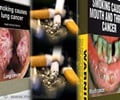The tobacco product landscape has changed significantly with the introduction of alternatives that are much less harmful than traditional cigarettes.

‘Decades-old tobacco control strategies that rely on an 'all or nothing' approach haven't kept up with these changes, and need to be modernized.’





"Not since the invention of the cigarette rolling machine in 1882 has the product landscape changed so dramatically. For the first time in over a century, there are products that could make the defective and deadly cigarette obsolete," says Lynn T. Kozlowski, co-author of the paper and professor of community health and health behavior at the University at Buffalo. "The dramatic landscape change warrants a rethinking of past tobacco control strategy, from an all-or-nothing approach to a harm-reduction approach," adds Kozlowski, who has written extensively on the need for including a harm-reduction approach in tobacco control efforts.
Kozlowski wrote the paper with David B. Abrams, executive director of the Schroeder Institute for Tobacco Research and Policy Studies at the Truth Initiative in Washington, D.C. Abrams is also professor of health behavior and society at Johns Hopkins University, and an adjunct professor of oncology in the Lombardi Comprehensive Cancer Center at Georgetown University Medical Center.
The researchers write that the long-held tobacco control strategy that lumps all tobacco products together - regardless of the differences in harm - is negatively impacting public health.
"In the past few years, more smokers now wrongly believe that Alternative Nicotine Delivery Systems, including electronic cigarettes, are as harmful or more harmful than cigarettes and are thus less likely to switch to them to quit smoking," says Kozlowski.
Advertisement
"Smokers who cannot, or do not, wish to quit smoking can now switch to a substantially less harmful, but reasonably satisfying, alternative way to get their nicotine. People smoke for the nicotine but die mostly from the tar," said Kozlowski.
Advertisement
The utter failure of these low tar/light combusted cigarettes to actually be less harmful does not mean that the same is true for modern non-combusted products like e-cigarettes, the researchers say.
In the 1980s, broader bans on cigarette advertising were proposed, and the dominant theme was that smoking is bad and there are no other product options to consider.
"Since 1964, major themes missed a core principle: The substantially greatest harm is from the toxic smoke of combusted, inhaled tobacco," Kozlowski and Abrams write.
At the same time as a harm reduction stance is adopted for smokers of deadly combusted tobacco, it is important to complement the decades of successful tobacco control, to minimize the use of any nicotine-containing products by underage youth, they say.
The new tobacco rules the U.S. Food and Drug Administration proposed earlier this month now include the regulation of previously unregulated cigars of all types, e-cigarettes and hookah.
"Despite our best efforts to prevent youth tobacco and nicotine use, most adult users will still likely have begun in their youth, and these adult users need legal options that are much less harmful than cigarettes," Kozlowski warns.
"Regulation should be used to strike the balance so urgently needed between protecting non-users, especially youth, while maximizing benefits of newly regulated non-combustible e-cigarette products that have been shown to help current smokers either to switch or, ideally, to quit," Kozlowski added.
The regulations need to be reasonable and proportionate so as not to stifle innovation or make the least harmful products subject to the most burdensome regulations, while allowing the most harmful combustible products to be subject to the most regulations, according to the researchers.
Source-Newswise










